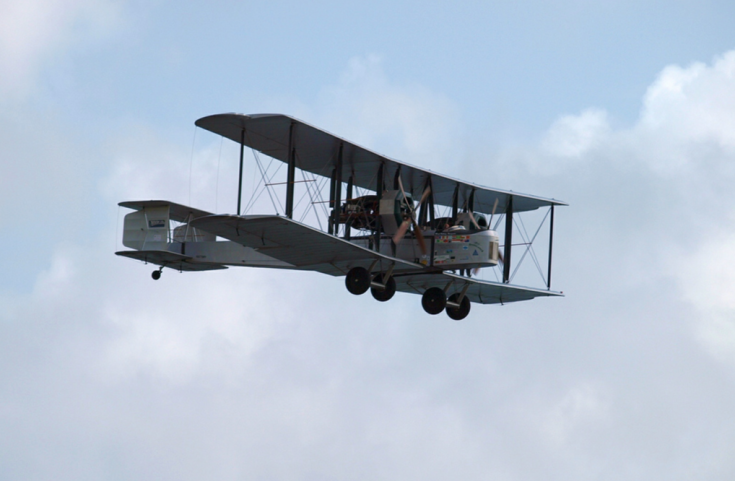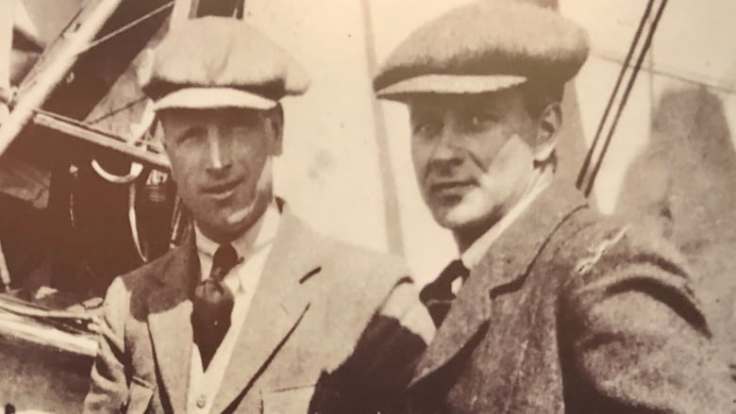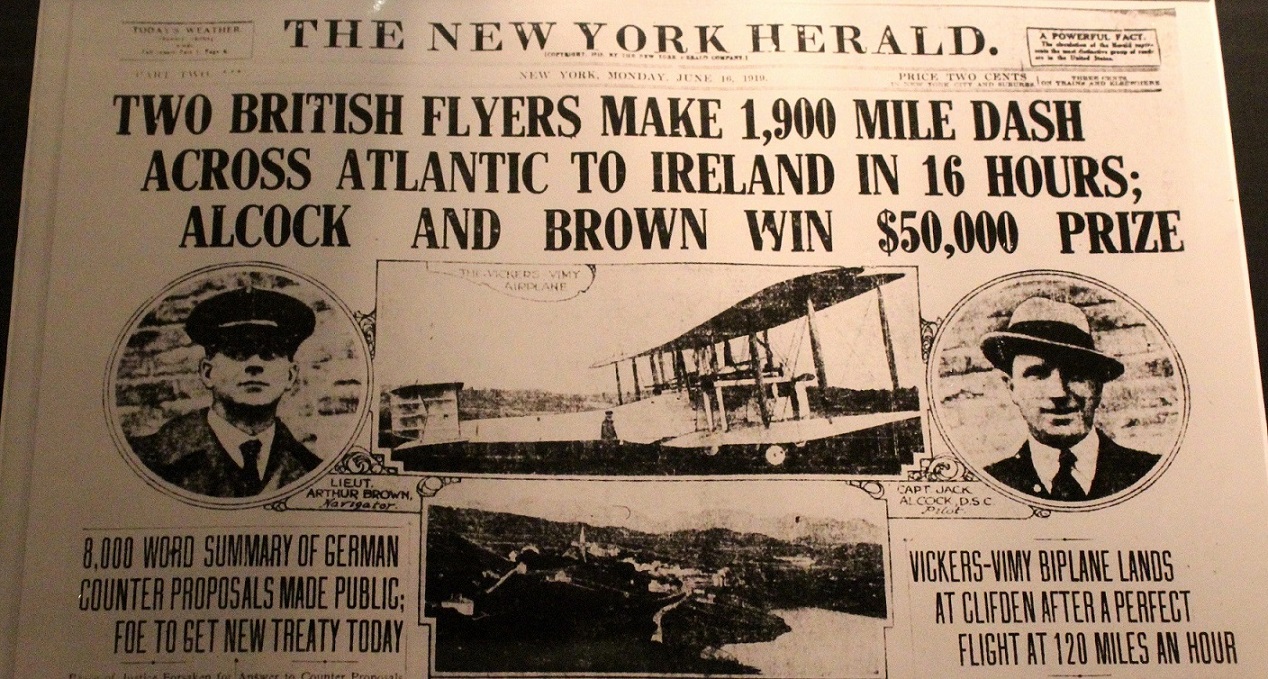Harry Sullivan twitched his ears. What on earth was that? As he listened, the throaty growl intensified. Was it coming from the sky? The seven-year-old leapt from his bed and ran out onto the streets of Clifden, Co Galway. ‘I was just in time to see this greyish-coloured machine swooping over the main street’, he recalls. ‘Its huge wings nearly touched the top of the church. I watched as it roared away towards the bog, its wings swaying up and down’.
It was 8:20am on Sunday 15 June 1919 and Harry had just witnessed one of the most magnificent events in aviation history. On that morning, 100 years ago today, Captain John Alcock and Lieutenant Arthur Whitten Brown completed the first ever non-stop trans-Atlantic flight between America and Europe.
The seed for Alcock and Brown’s extraordinary adventure began in the winter of 1918 when Lord Northcliffe, the Dublin-born founder and proprietor of the Daily Mail, renewed his offer of a prize, worth £10,000 (approximately STG£400,000), for the first team to fly non-stop across the Atlantic.[i]
 In early 1919, Percy Muller, superintendent of the Vickers works at Broadlands, Surrey, asked one of his test pilots what he thought of the contest. Jack Alcock replied: ‘I am on it any old time!’ Alcock had been obsessed with flying since he began making model planes during his childhood at Old Trafford, Manchester.[ii] By 1912, he was working as a mechanic at Broadlands where he learned how to fly.[iii] He served with the air-force during the war, targeting U-boats in the Dardanelles, but was shot down, captured and imprisoned in a Turkish POW camp.
In early 1919, Percy Muller, superintendent of the Vickers works at Broadlands, Surrey, asked one of his test pilots what he thought of the contest. Jack Alcock replied: ‘I am on it any old time!’ Alcock had been obsessed with flying since he began making model planes during his childhood at Old Trafford, Manchester.[ii] By 1912, he was working as a mechanic at Broadlands where he learned how to fly.[iii] He served with the air-force during the war, targeting U-boats in the Dardanelles, but was shot down, captured and imprisoned in a Turkish POW camp.
With his eye now fixed upon the Atlantic Prize, Alcock sought a plane strong enough to win. He settled upon a Vickers Vimy IV, to be modified at Broadlands and fitted with two Rolls Royce engines. Now he needed someone capable of navigating the featureless 2,000-mile ocean without straying off course.
The meeting of Alcock and Brown took place completely by chance. Born in Glasgow in 1886, ‘Ted’ Brown was the son of an American engineer. Like Alcock, his passion for aviation stemmed from childhood, when he made and flew box kites. He served in the army at the Somme, before joining the Royal Flying Corps as an observer. In 1915, his plane was downed and, his right leg shattered, he was incarcerated in a POW camp in Germany. After the war, he started work with the Aircraft Production Department who, one day, sent him to discuss radiators with Peter Muller at Vickers. Alcock happened to be in the room with Muller when Brown arrived. Muller introduced the two men. They shook hands. And something peculiarly British happened.
Alcock told Brown about the Daily Mail contest. Brown told Alcock how he would navigate the Atlantic if he were to enter such a prize. Impressed, Alcock asked Brown if he would care to join him on the journey. Brown said he would be delighted to. And so the team was born.
Aged 33, Ted Brown was a thoughtful, unassuming individual, somewhat scarred by his memories of the Somme but due to marry a beautiful Irish girl called Marguerite Kennedy. An optimist, he regarded aviation as an ideal tool for promoting peace and prosperity across the world. Six years his junior, Jack Alcock was the more daring of the two, an acrobatic specialist who simply saw the flight as a tremendous adventure.[iv] Together the two former POWs plotted every last detail of the journey, right down to their electrically heated Burberry’s flying suits.
Their late entry ensured they were rank outsiders for the Atlantic Prize when they finally joined their seventeen rival teams at the take-off spot in St John’s, Newfoundland.[v] In the days leading up to the race, most of their competitors were obliged to withdraw with technical faults.[vi] At length, only four planes participated.[vii]

On the afternoon of Saturday June 14th 1919, Jack Alcock pulled the Vimy bi-plane into the sky above St John and roared into the dense, clinging fogs of Newfoundland’s coast.[viii] They would not see land again until Ireland.
Alcock and Brown’s circumstances required immense courage and endurance. The Vimy was a primitive beast. The wind whined ‘a ghostly melody among the struts and bracing wires’. It had an open cockpit, meaning that every time they passed through a band of rain, hail, sleet or snow – which they did frequently – it ‘chewed bits out of our faces’, to quote Brown.[ix] They were not long in the air when their radio broke. The exhaust snapped soon afterwards and the resultant sound, which Alcock likened to a machine gun battery, left the two men with hearing problems for the rest of their lives.
During the night, they had no option but to ‘cleave our way through an interminable mass of black marble’, with the luminous glow of the instrument panel providing just enough light for Brown to read the chart spread upon his knees. He skilfully steered them into a westerly wind that blew them towards Ireland. But that was accompanied by an intense blast of sleet which jammed the lateral control for half an hour.[x] It was extremely hard, physical work. Anything could have gone wrong at any moment. Not a pleasant thought when you are carrying a colossal 865 gallons of fuel, spread between seven tanks and a service tank.[xi]
At last, daylight broke and there was land ahoy in the shape of the islands of Eeshal and Turbot off the Galway coast. Brown recognised the tall radio masts of Marconi’s station at Clifden and recalled how, just days earlier, they had joked about hanging their hats on the aerial as they passed.[xii] Flying over Clifden, they fired two red flares but most of the town’s population were in church at the time. Alcock had hoped to fly all the way to Brooklands but with the mist-shrouded mountains of Connemara rising before him, he wisely decided to land. He aimed for a pristine, treeless field by the Marconi station. To both men’s surprise, they landed violently with ‘an unpleasant squelch’. The field was in fact the spongy blanket bog of Derrygimla.[xiii] As the startled Marconi crew reached the peat-drenched airplane, Alcock stood up from his seat, removed his goggles and said: ‘We are Alcock and Brown. Yesterday we were in America’.
It was 9:40am on Sunday morning. They had completed the 1,880-mile coast-to-coast flight in 15hr 57min at an average speed of 118.5mph. It was the longest distance ever flown by man. ‘What do you think of that for fancy navigating?’ asked Brown. ‘Very good’, replied Alcock. And they shook hands again.[xiv]

Ireland erupted on discovering what the two men had achieved.[xv] The older generation were particularly stunned. The voyage to America had always taken weeks. Yet this flying machine had done it in sixteen hours. On the road to Galway, Alcock and Brown were obliged to shake several thousand hands along the way. The train journey to Dublin involved standing ovations at every station. They were smothered in flowers by the children of Athenry and celebrated by a marching band in Mullingar. When they arrived in Dublin, a group of Trinity students ‘kidnapped’ Alcock and brought him to their Commons for a jar. Meanwhile Brown was dragged off to the Royal Irish Automobile Club on Dawson Street to regale its members with every last detail. The next day, huge crowds gathered in Dun Laoghaire to watch them sail for Holyhead. In England, knighthoods, portraits and a £10,000 check awaited.[xvi] Presenting the check at an elaborate luncheon in London, Winston Churchill hailed Alcock and Brown’s success as ‘a triumph of man over nature’.
It was certainly one of the most significant and dramatic flights in aviation history.[xvii] Nobody repeated the feat for eight years. It also marked the peak of both men’s career. Sir John Alcock was killed less than six months later – and only nine months after he and Brown first met – when his plane crashed in France.[xviii] Sir Arthur Brown married his Irish sweetheart and survived until 1948.[xix] But their triumph was an event of tremendous positivity for a world which, in 1919, was still riddled with self-doubt after the horrors of the Great War and the Spanish Flu. Moreover, America was suddenly less than a day away.[xx]
In 1959, a 14ft-high limestone monument of the ‘tail-fin’ was erected on Ballinaboy Hill, the quiet, primeval boulder-strewn Connemara bogland, over which the Vimy had flown on its way to the nearby Marconi station. It’s inscription reads: ‘Ta a ngaisce greannta as chlar na speire. Their heroism adorns the expanses of the sky’. In July 2005, the late Steve Fossett and Mark Rebholz completed their 18 ½ hour re-enactment of the flight and landed at Ballyconneely’s golf club.
Brendan Lynch’s book, ‘Yesterday We Were in America’ is a thoroughly researched and often exciting account of the pioneering flight, crammed with useful anecdotal tangents and informative titbits.
FOOTNOTES
[i] Northcliffe had been pushing for aviation progress since at least 1906. After the Reims Airshow of 1909, he launched a series of prizes for pilots who could, for instance fly in one day from ‘within 5 miles of the London office of the Daily Mail ‘to a given spot within 5 miles of the Manchester office’. The original Atlantic Prize of £10,000 was offered, on 1st April 1913, to the first person who could cross the Atlantic within 72 continuous hours. Many viewed it as an April Fool’s joke; Punch magazine quickly a similar prize for the first flight to Mars. The offer was put on hold with the outbreak of war. When he died, Lord Northcliffe willed three months salary to each of his 6,000 employees.
[ii] By 1908, he was helping build a real Farman-type bi-plane.
[iii] Brooklands placed Alcock at the hub of British aviation, with such legends as Louis Bleriot and Lord Brabazon of Tara regularly calling by. Alcock was actually taught how to fly by Maurice Ducrocq, the eminent French aviator who ran a flying school at Brooklands.
[iv] Aside from some minor debates over the limited cockpit space for their respective instruments, the navigator and pilot got on famously.
[v] Other scheduled competitors included Tommy Sopwith, Paris Singer and the wartime pilot Leth Jensen who boasted that he would get all the way to Paris.
[vi] In those early days of flimsy airplanes, unpredictable instruments and snappable wings, a pilot’s life was a perilous one. No bomber, seaplane, biplane or triplane was safe. Among those killed flying was Charles Rolls (1877-1910), co-founder of Rolls Royce company whose engines would power Alcock and Brown into trans-Atlantic success. Countless aviators perished in their attempts to fly the Atlantic from Paris to New York, including Irishmen James Medcalf and Terence Tully. In 1927, Charles Lindberg succeeded in the Spirit of St Louis, the first solo crossing of the Atlantic.
[vii] The first to depart was the Sopwith team who promptly went missing, its crew presumed dead. When they were found safely bobbing in the ocean some days later, the press went into overdrive and the Atlantic Race became front page news across the Western World.
[viii] When the news reached Lord Northcliffe’s Daily Mail office on Fleet Street, the editor quaked. The Saturday take-off was the worst news possible; the Mail did not then have a Sunday edition! Sure enough, they were scooped by the Express
[ix] Lynch describes the cockpit as like a 1920s domestic hallway, with brass switches and ivory levers mounted on a varnished wooden fascia.
[x] There were also endless dispiriting levels of cloud to negotiate. When they completed 850 miles, they celebrated with a cup of coffee from a thermos.
[xi] Fuel consumption was estimated as 70 litres an hour and they aimed to travel at 90mph.
[xii] It was not lost on either men that Marconi had installed another Telegraph Station back at St John’s, Newfoundland. Set amid the empty boglands and mountains, the high-power, long-wave Marconi Station was later burned by nationalists in 1922. Ireland and Newfoundland were united again in 1928 when Captain James Fitzmaurice (who Lynch called ‘Ireland’s most neglected aviation hero’, suggesting his next book?) co-piloted the first successful east-west crossing from Dublin’s Baldonnel Airport to Greenly Island, Newfoundland, and again in 1932 when Amelia Earhart landed in Culmore, Co Derry, becoming the first woman to fly the Atlantic solo.
[xiii] The Vimy’s nose and half its propellers were buried in peat, and the tailplane elevated 16 ft high.
[xiv] Inevitably, elements of the journey were subsequently exaggerated, by the press and other writers. Lynch comprehensively dismisses the legend that the handicapped Brown walked on the iced-up wings to clear the ice and snow which had blocked the engine’s air intakes, a legend of Bigglesian proportions. He was, however, constantly chipping ice off the fuel gauge with a knife.
[xv] A quick reception in Clifden’s Railway Hotel and then they were driven on to Galway where they slept in the Great Southern and were gifted Claddagh rings by local jeweller William Dillon. When they awoke, they were global celebrities. It was, said Brown ‘a wonderland of seeming unreality’.
[xvi] A quarter of a million people gathered in London to welcome the two former prisoners-of-war. They were soon kneeling before George V and knighted. In the months that followed, Jack Alcock and Arthur Whitten Brown were touted far and wide for their achievements. They sat for portraits by Sir John Lavery and Ambrose McEvoy. Mahogany models of the Vimy went on sale, with propellers that revolved when the model was wheeled and a stash of matches in the tail end.
[xvii] It was certainly the greatest leap for mankind since the Wright Brothers staggered into the air in their powered airplane sixteen years earlier. Lynch hails the journey as ‘the logical outcome of man’s obsession with transport, which dated from the invention of the wheel in Mesopotamia around 4000BC’.
[xviii] After the flight, Sir John Alcock returned to testing Vickes aeroplanes at Brooklands and began plotting a new motor business in the Burlington Arcade in London. On 15 Dec 1919, now aged 27, he attended the presentation by Vickers of the transatlantic Vimy to London’s Science Museum. The plane had been washed clean of Irish peat and its nose repaired. (Some of the Connemara locals appear to have nabbed some parts of the plane, such as its canvas and propellers, for their curio collection). Three days later, he entered the cockpit of a single-engine Vickers Viking Mark I amphibian bi-plane and set off for the first post-war aero-nautical exhibition in Paris. The plane vanished into the low clouds of the English Channel. 25 miles north of Rouen, a farmer watched the Viking attempt an emergency landing when it suddenly collapsed in the blustery sky, ‘gave a great sway and fell to the earth’. Alcock’s head smashed into the windscreen, fracturing his skull. He never regained consciousness. His funeral took place in Manchester cathedral on Christmas Day and he was buried in the city’s Southern Cemetery beneath three coach-loads of wreaths. A Celtic Cross was later erected over his grave, an aeroplane propeller carved in its base.
[xix] On 29 July 1919, Sir Arthur Whitten Brown, resplendent in blue RAF uniform, married curly dark haired Marguerite Kathleen Kennedy in London. They would be feted on their honeymoon, an extended trip through America with Kathleen now known as ‘Lady Whitten Brown’. Brown subsequently became general manager of the Metropolitan Vickers plant in Swansea. Shocked by Alcock’s death, he became rather withdrawn in later years. During the Second World War, he helped train RAF pilots in navigation and engineering. His idealistic hopes that aviation would promote world peace were shattered and he knew many who perished in the blitz. His only son was shot down while flying over northern Holland. He recoiled from the use of planes at Dresden and Hiroshima. On 4 October 1948, he overdosed on barbitone at his home in Swansea and died. He was 62 years old.
[xx] As Brown said, this was the first generation of mankind ‘to see flying dreams and theories translated into fact’. He foresaw a future where aviation could create the possibility of a peaceful, prosperous would, where flight would knit the world together, not become the latest weapon.
In 1939, the first direct flight of a commercial flying boat from Foynes, Co Limerick, to New York, was flown by Charles Blair, husband of the actress Maureen O’Hara.


June 15, 2019 at 2:37 pm
What a great, well researched post
LikeLike